| GISdevelopment.net ---> AARS ---> ACRS 1999 ---> Poster Session 2 |
A new Composite Method for
NOAA/AVHRR GAC Global Product
Masayuki Matsuoka* **, Koji
Kajiwara**, Toshiaki Hashimoto** and Yoshiaki Honda**
*Peppers, Crest, Japan Science and Technology Corporation
**Center for Environmental Remote Sening, Chiba University
1-33 Yayoi-cho, Inage-ku, Chiba, 263-8522
Tel: (81)-43-3845 Fax: (81)-43-290-3835
E-mail : matsuoka@ceres.cr.chiba-u.ac.jp
JAPAN
Keywords
: Composite, AVHRR, GAC, global product*Peppers, Crest, Japan Science and Technology Corporation
**Center for Environmental Remote Sening, Chiba University
1-33 Yayoi-cho, Inage-ku, Chiba, 263-8522
Tel: (81)-43-3845 Fax: (81)-43-290-3835
E-mail : matsuoka@ceres.cr.chiba-u.ac.jp
JAPAN
Abstract:
A composite method for NOAA/AVHRR data over land is proposed. This method is based on Maximum Value Composite (MVC) using NDVI and consists of three consecutive criteria with NDVI, brightness temperature derived from channel 4 and scan angle. A global product with 4 km resolution produced by this method is compared with that of MVC from the viewpoints of elimination of clouds, relations to adjacent pixels and smallness of scan angel.
1.Introduction
Time series of global product with 4 km resolution has been produced from NOAA/AVHRR GAC in Center for Environmental Remote Sensing (CERes), Chiba University. Composite is the final process to produce daily product from georectified path images, and 10-day composite product from ten daily products. The MVC and showed that the MVC has tendency to select data from near-nadir region and minimize the influence of the clouds atmosphere (air molecules, water vapour and aerosols) and bi-directional reflection. Some our attempts resulted that the MVC selects data normally from forward-scatter region, and extremely off-nadir region in some cases. Therefore, the influence of atmosphere and bi-directional reflection is greater and size of footprint is larger than nadir. Chilar et al. (1994) evaluated five composite criteria (three single -step criteria: maximum NDVI, maximum apparent temperature and maximum difference of channels 2 minus 1, and two two-step criteria: maximum NDVI followed by maximum temperature or minimum scan angle). They concluded that maximum temperature and maximum NDVI followed by minimum scan angle were the most effective one- and two-step criteria, respectively, and maximum NDVI criterion preferentially selected off-nadir pixels from the forward-scatter region. Stoms et al. (1997) Developed the multiple-objective composite method based on three-dimensional Euclidean distance consist of NDVI, apparent temperature and satellite zenith angle, and resulted that it was superior to MVC and maximum apparent temperature composite from two points of view: the satellite zenithe angle distribution was more closely clustered about nadir, and neighboring pixels are more frequently selected with similar viewing geometry and atmospheric conditions.
In this paper, a new composite method is proposed, which is based on the MVC and is improved by adding two criteria: maximum brightness temperature and minimum scan angle. Evaluation is made by comparison with the MVC itself from the viewpoints of elimination of clouds, relations to adjacent pixels, and smallness of scan angle.
2. Methodology
This method, hereafter referred to as N4SC (i.e. maximum NDVI- Maximum channel 4 brightness temperature - minimum scan angle composite) consists of three selections and two checks between these selections. Processing flow and the concept is shown in figure 1.
 (a) |
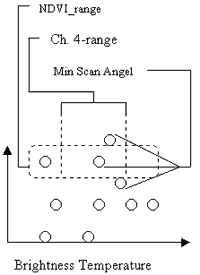 (b) |
| Figure1. (a) processing flow of the composite method. Square and ellipse mean" selection" and "check", respectively. (b) Conceptual scattergram of NDVI and brightness temperature | |
SZA_check: The availability of NDVI is examined by solar zenith angle as preprocess. NDVI value is high and unreliable in twilight region at high latitude independently on the surface reflectance, because of low radiance signal and long path length (Holben 1996). Therefore If the pixel has any data with solar zenith angle greater than threshold value (70 degrees at present), it will be composited by Maximum_Ch.4_selection.
Maximum_NDVI_selection: The data with maximum NDVI is selected just like MVC.
NDVI_range_check: the difference of each NDVI from maximum is examined. If the difference is within the threshold, the data is kept as kept as a candidate for next selection. This process aims at avoiding overestimation of NDVI by selecting from forward-scatter region, and at retaining the data from nadir region. Although it is supposed that the threshold value has varies with the season and/or geographic location, it is fixed at value 0.05. If no data has passed this check, the data with maximum NDVI is selected for composite data.
Maximum_Ch.4_Selection: The data with maximum brightness temperature derived from channel 4 is selected out of candidates passed above range check. This aims at eliminating clouds over less vegetated area where has low NDVI similar to clouds.
Ch.4_range_check: The difference of brightness temperature between each data and maximum is examined. The all data within the rectangle in figure 1(b), are considered as equivalent in availability for composite. Threshold value is a fixed at 10.0 in Kelvin.
Minimum_ScanAngle_selection: Finally, data with minimum scan angle is selected for composite to minimize the influence of atmosphere, bi-directional reflection and size of footprint.

Figure 2. Definition of value DIFF to evaluate "Speckle" in this study.
This method is applied for global product generated in CEReS and the result is compared with the MVC. The period of the composite is 10 days from 80th to 89th day of the year 1993. Comparison is done for pixels that selected by different composite method (i.e., by maximum_NDVI_selection in the MVC and maximum_ch.4_selection and Minimum_ScanAngle_selection in the N4SC). The points of evaluation are as follows: 1) Histograms of NDVI and reflectance. 2) Histogram of scan angle. Point 2 and 3 aim at evaluating "speckle" (i.e., higher local variance in image) and at evaluating whether the image is approximate the single data, near-nadir image.
3. Results and Discussion
Each composite result is shown in figure 3. N4SC and MVC look similar, however, 72 percent of pixels ware passed Maximum NDVI selection and proceeded to NDVI_range_check in N4SC, and in 43 percent of the passed pixels, different day is selected for composite.

(a) N4SC
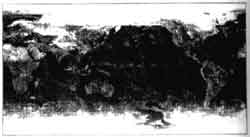
(b) MVC
Figure 3. Composite results (channel 1:2:1 =R:G:B)

Figure 4. Histograms of NDVI and reflectance of channel 1 and 2. The vertical axis is frequency in percent. -:N4SC : MVC
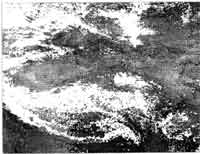
(a) N4SC
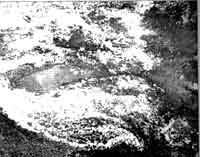
(b) MVC
Figure 5. Composite images around Taklimakan desert (channel 1:2:1 -= R:G:B)
Histograms of NDVI and reflectance for channel 1 and 2 are shown in figure 4. The N4SC has high frequency in the minus range in NDVI, while the MVC has a peak around zero. In reflectance, the N4SC has frequencies higher than the MVC around 10 percent, but opposite situation in reflectance over 60 percent. This indicates that the N4SC could avoid the clouds over the low NDVI region like desert DUE TO brightness temperature, as shown in figure 5, though the MVC selected clouds.
Histograms of DIFF, defined in figure 2, are shown in figure 6. DIFF of the N4SC is greater than the MVC in NDVI and lower in reflectance. That is to say, Image by the MVC has high local variance in reflectance as shown in figure 7, although it looks "smooth" in NDVI.

Figure 6. Histograms of DIFF for NDVI and reflectance of channel 1 and 2. The vertical axis is frequency in percent. -: N4SC -: MVC
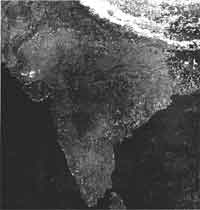
(a) N4SC
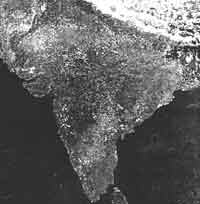
(b) MVC
Figure 7. Composite images around India (channel 1:21 = 1:2L1 = R:G:B)
Histogram of number of day in adjacent pixels is shown in figure 8. This means that, in adjacent eight pixels, how many different day from center pixel is selected (if all pixels selected from same day as center pixel, the number is zero. The maximum number is eight in case that all adjacent pixels and center pixel are selected from different day each other). In the N4SC, neighboring pixels are selected from same day or another day, therefore image is looks like patches of daily image. On the other hand, larger number of day is used in the MVC and that's the reason of high local variance and speckle-like image as figure 7(b).
Histogram of scan angle is shown in figure 9. Distribution of can angle in the N4SC is clustered about nadir, while that in the MVC is spread in all angle with a little biased in forward-scatter region. It is evident that Influence of atmosphere and bi-directional reflection and size of footprint is less in the N4SC than in the MVC.
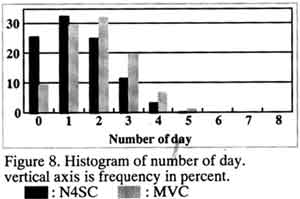
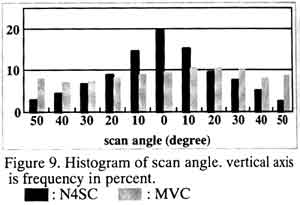
4. Conclusions
A New composite method, which is based on three consecutive criteria with maximum NDVI, maximum brightness temperature derived from channel 4, and minimum scan angle, is proposed and evaluated by comparing with the MVC method using AVHRR GAC global product. The results show several improvements. First, clouds over low vegetated area is eliminated due to brightness temperature. Secondly, image of reflectance looks patch-like image of daily images rather than speckle-like image. Finally, scan angle distributes closer to nadir, which makes the influence of atmosphere and bi-directional reflection weak and makes the size of footprint small.
Acknowledgement
This study has been supported by CREST of JST (Japan Science and Technology).
Reference
- Cihlar, J., Manak, D., and D'Iorio, M., 1994. Evaluation of Compositing Algorithms for AVHRR Data Land. IEEE Transactions on Geoscience and Remote Sensing, 32(2), pp. 427-437.
- Gutman, G., 1989. On the relationship between monthly mean and maximum -value composite normalized vegetation indices. International Journal of Remote Sensing, 10(8), pp. 1317-1325.
- Holben, B.N., 1986. Characteristics of maximum-value composite images from temporal AVHRR data. International Journal of Remote of Remote Sensing, 7(11), pp. 1417-1434.
- Stoms, D.,M., Bueno, M.,J., and Davis, F., W., 1997. Photogrammetric Engineering & Remote Sensing, 63(6), pp. 681-689.